2020年暖心冬至·关怀送爱 线上展览与文化知识问答
Winter Solstice Festival 2020 · Love is Always Around Online Exhibition & Quiz
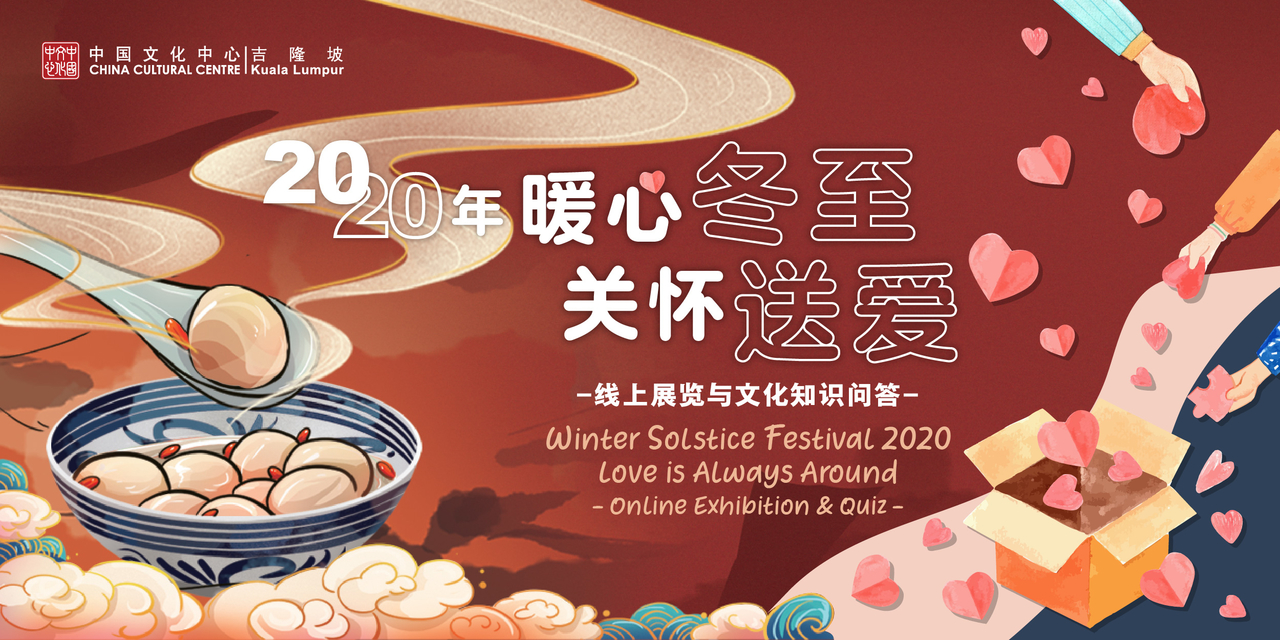
冬至是中华民族的传统节日,兼具自然与人文两大内涵,既是自然节气点,也是各家庭团聚庆贺和祭祖的节日。冬至被视为冬季的大节日。在民间广泛流传着“冬至大如年”的讲法,一是说明年关将近,二是表示冬至的重要性。冬至一到,新年就在眼前,所以古人认为冬至的重要程度并不亚于新年。
Traditionally, the Winter Solstice (Dong-Zhi) Festival is a time for the family to get together. The festive food, Tangyuan, is also a reminder that celebrators are now a year older and should behave better in the coming year. Even today, many Chinese around the world, especially the elderly, still insist that one is “a year older” right after the Dongzhi celebration instead of waiting for the lunar new year.
冬至,坐落于今年的12月21日,是太阳直射南回归线的日子。 在这一天,北半球的日照时间是一年当中最短的,而夜晚则是最长的。 中国古代就有“冬至大如年”的说法。 最早关于冬至的记载可以追溯到汉代(公元前206年-公元220年),那时的冬至被称为“冬节”,但正式的节庆活动是在唐代(618-907年)和宋代(960-1279年)期间开始。 这天,朝廷上下要放假休息,商旅停业,过一个“安身静体”的节日。在古代,冬至是个祭祖和团圆的日子,亲朋各以美食相赠,相互拜访,摆酒设宴。 因此,冬至也被称为“小年”。
Winter solstice (Dong-Zhi), which falls on December 21st this year. On this day, the sun directly crosses the Tropic of Capricorn and the northern hemisphere has the shortest day and the longest night.
There was an old saying that went in ancient China, “Winter Solstice is as significant as the new year”. Although records of people celebrating Winter Solstice date back to the Han Dynasty (206 BC-AD 220), celebrations really took off during the Tang (618-907) and Song (960-1279) dynasties. On this day, the imperial court had a holiday and rested. Some folks also maintained customs such as ancestor worship and family reunion. Therefore, Winter Solstice is also known as the “small New Year”.
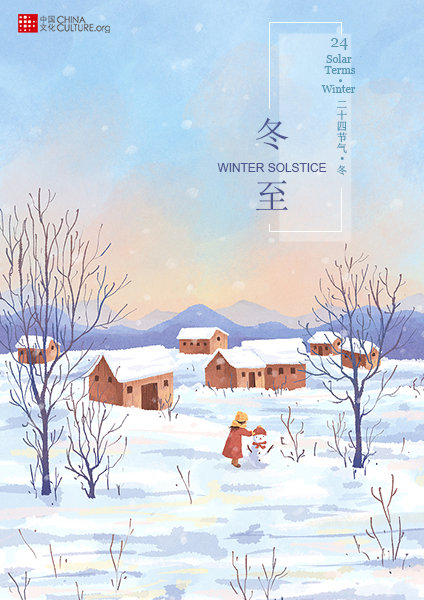
《小至》———-杜甫(唐)
“天时人事日相催,冬至阳生春又来。
刺绣五纹添弱线,吹葭六琯动浮灰。
岸容待腊将舒柳,山意冲寒欲放梅。
云物不殊乡国异,教儿且覆掌中杯。”
“Heaven and earth press for a change from day to day;
On Winter Solstice spring will come without delay.
The embroiderer adds in an hour one more thread;
When six reed pipes are blown, up and down ashes spread.
The river shores wait to be greened by willow trees;
The cold -proof mountain prepares to release plum blossoms.
The scenery here looks as fine as in our homeland;
I tell my son to drink up the cup in his hand”
Winter Solstice———- Du Fu, Tang Dynasty

冬至的7个习俗
7 Customs You May Not Know About Winter Solstice
1.吃饺子 Eating Dumplings
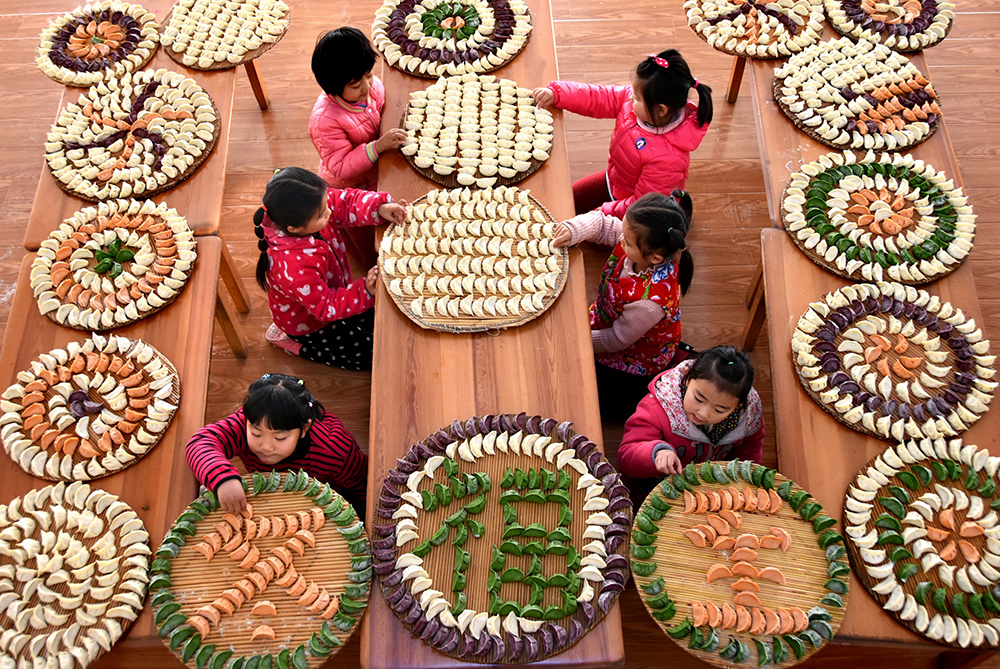
在中国北方的冬天,吃饺子是节日必不可少的一部分。此习俗据说起源于汉代张仲景。传说在一个寒冷的冬日,他看到了穷人们在天寒地冻的环境中冻伤了耳朵。他感到十分同情,于是命令他的学徒们用羊羔和其他材料做成饺子,并把它们分给穷人,使他们取暖,使他们的耳朵免受冻疮的影响。因为饺子的形状像耳朵一样,张仲景把这道菜取名为”袪寒娇耳汤”,也有把寒气和感冒排出的功能。在河南,当地的百姓从古时便承袭了这一习俗,认为冬至节吃饺子,可以驱寒祛病。
During the Winter Solstice in Northern China, eating dumplings is essential to the festival. It is said to have originated from Zhang Zhongjing in the Han Dynasty. On one cold winter day, he saw the poor people suffering from chilblains on their ears. Feeling sympathetic, he ordered his apprentices to make dumplings with lamb and other ingredients, and distribute them among the poor people to keep them warm, to keep their ears from getting chilblains. Since the dumplings were shaped like ears, Zhang named the dish “qùhán jiāoěr tāng” or dumpling soup that expels the cold. In Henan, people hand down this custom since they believed it was able to fend off a chill and get rid of illness to eat dumplings.
2.吃汤圆 Eating Tangyuan

在中国南方,人们吃的是象征着团圆的汤圆。南方人过冬至时,不仅是至亲家人,也会与亲朋好友共聚一堂吃汤圆。根据古老的传统,他们会要求同姓或同族的人在他们祖传的寺庙中聚集,以在这一天进行祭祖活动。在祭祀仪式后,就会有一次盛大的聚会晚宴。在中国,吃汤圆是中国人的传统习俗,在江南尤为盛行。民间有“吃了汤圆大一岁”之说。
In Southern China people eat Tangyuan, which means reunion. It not only eaten by the family, it is also shared with friends and relatives as a blessing. Ancient traditions also require people with the same surname or from the same clan to gather at their ancestral temples to worship on this day. There is always a grand reunion dinner following the sacrificial ceremony. The festive food is also a reminder that celebrators are now a year older and should behave better in the coming year. Even today, many Chinese around the world, especially the elderly, still insist that one is “a year older” right after the Dongzhi celebration instead of waiting for the lunar new year.
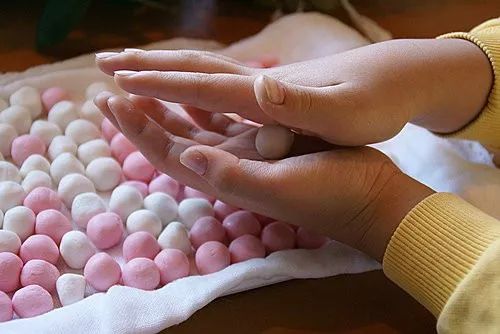
汤圆是一种由糯米粉制成的中式甜点,该甜点把糯米粉与少量水混合后搓成球状,然后在添加了姜的糖水中煮熟。汤圆通常都是与家人一起享用。这是因为汤圆和碗的形状,象征着一家人团圆,和乐温馨。
Tang yuan is a Chinese dessert made from glutinous rice flour mixed with a small amount of water to form balls and then either cooked and served in boiling water with fermented glutinous rice, or sweet syrup, or deep fried. For many Chinese families in China as well as overseas, tangyuan is usually eaten together with family. The round shape of the balls and the bowls where they are served, come to symbolize the family togetherness and reunion.
3.吃红豆糯米饭 Eating Red-bean and Glutinous Rice

在江南一带,每逢冬至节的夜晚,全家人都要团聚在一起,共同享用甜美的红豆糯米饭。有关这一习俗,还有一个有趣的故事。传说,在江南一带有个凶神恶煞的厉鬼,经常出来残害百姓。街坊邻里一到夜晚,便就家家闭户,不敢外出。但是这个厉鬼有个致命的弱点,就是害怕红豆。于是,人们在冬至节这一天吃红豆糯米饭,以驱逐厉鬼,防灾祛病。
In the south of Yangtze River, the whole family get together to enjoy the sweet polished glutinous rice with red beans every Winter Solstice. There is a funny story about this custom that there was a cruel ghost who always did harm to people in the areas around the south of Yangtze River. All neighbors had to close the door and frightened to go out when night came. But the ghost had a fatal weakness that he was afraid of red beans. Therefore, people eat polished glutinous rice with red beans to drive out the ghost, prevent disasters and get rid of illness.
4.吃年糕 Eating Rice Cake
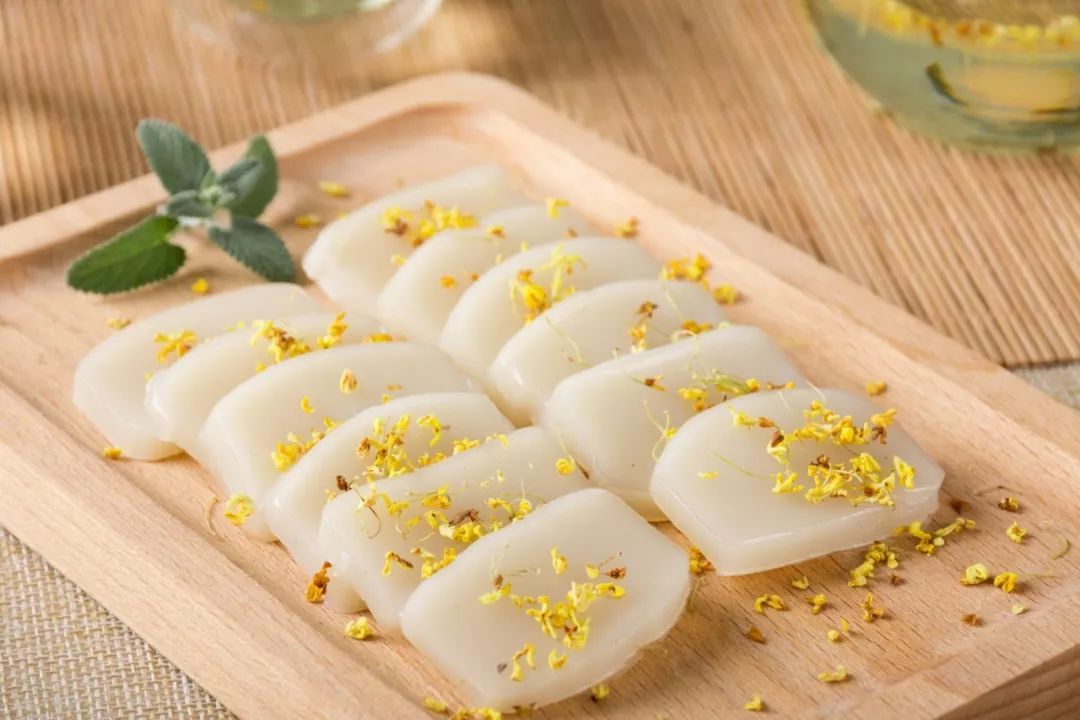
年糕是中国特有的风味小吃,老少咸宜。在南方,每逢冬至节的时候,人们都特别喜爱吃年糕。人们在这一天,要制作各种不同风味的年糕,例如芝麻拌白糖的年糕、油炒年糕、笋丝汤年糕等。按照民间的说法,冬至这天吃年糕,喻示年年长高,以祈求吉祥。
The rice cake is a particular Chinese taste snack suitable for both the young and the old. In the Southern China, when it comes to Winter Solstice, people usually eat their favorite rice cakes of different tastes such as rice cakes with sesame and white sugar, fried rice cakes and rice cake soup. According to the folklore, eating rice cakes can help people grow taller year by year, and desire for good luck.
5.赠鞋 Presenting Shoes
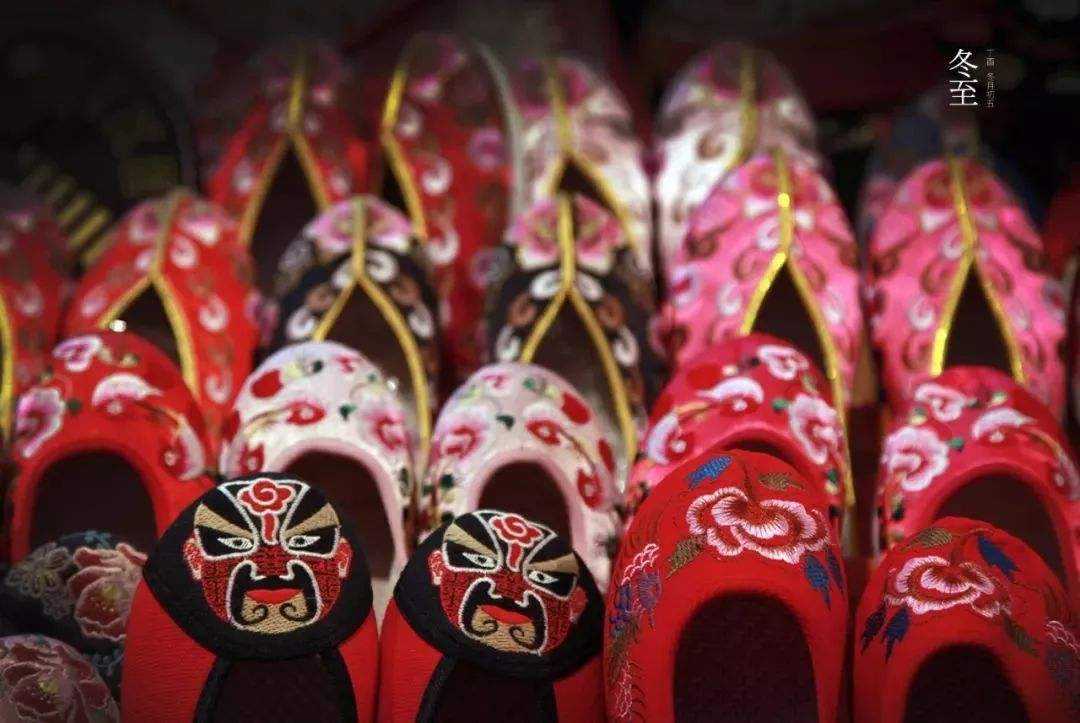
在民间,冬至节有互相赠鞋子的习俗。相传在汉代的时候,人们就有互相赠鸳鸯鞋的习俗。后来逐渐演变成舅姑将鞋赠送予外甥或侄子,以表达良好的祝愿。在以往的刺绣制品中,给男子送的礼物,多做成虎形或狗形,鞋上多绣的是野兽。送给女子的礼物,多做成凤形,鞋帽上绣的多是花鸟。
Presenting shoes is another custom in folklore on the Winter Solstice. It is said that, people had the custom of giving shoes of mandarin ducks as a gift to each other in the Han Dynasty. Afterwards, the custom has developed into a tradition that uncle or aunt presents shoes or hats to nephews to express their best wishes. Former embroideries presented to men are made in the shape of a dog or a tiger mostly, with beasts embroidered on it. The gifts for women are made in the shape of a phoenix, with flowers and birds embroidered on it.
6.尊师 Respecting Teachers
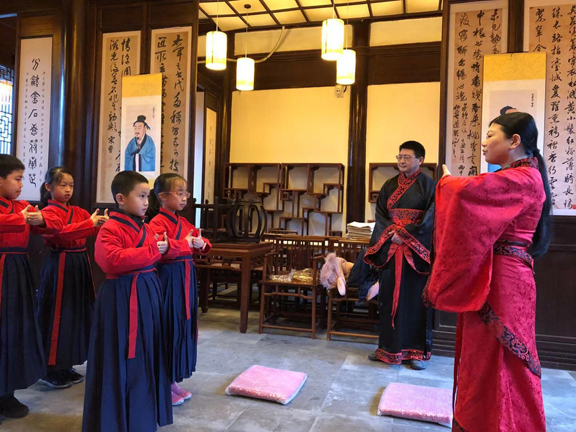
在古代,冬至节有宴请教书先生的习俗。先生要带领学生祭拜孔子牌位,然后学生再祭拜先生。在山西民间,还流传着“冬至节教书”的习语。不少地方还盛传冬至节请教师吃饭的习俗。尤其在北方地区,人们习惯用炖羊肉来招待老师。
In ancient times, people had the custom of inviting teachers to dinners on Winter Solstice. Students will bow to the teacher after the teacher leads the students to worship the memorial tablet of Confucius first. In the folklore of Shanxi, there is a prevalent idiom of do the teaching in the Winter Solstice. In the Northern China, stewed mutton is always used to entertain teachers.
7.喝冬酿酒 Drinking Winter Wine
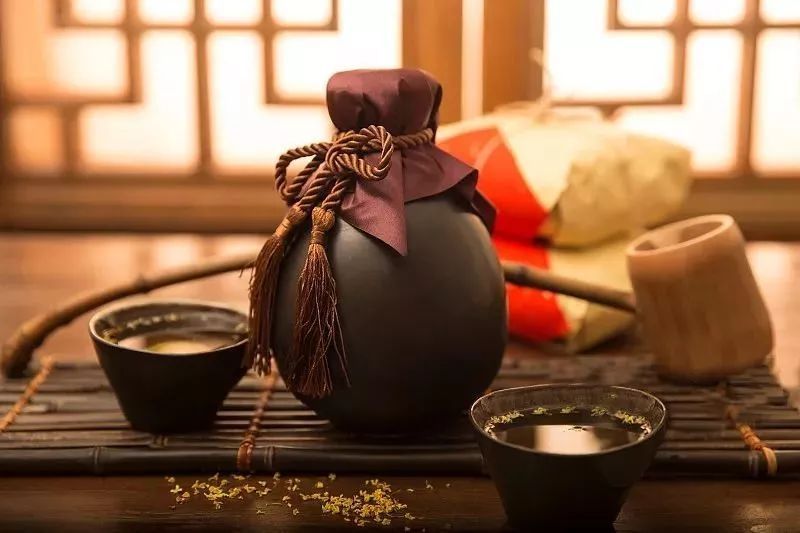
冬酿酒是苏州人在冬至节必饮的一种酒。冬酿酒是一种米酒,加入桂花酿造,香气宜人。姑苏百姓在冬至夜畅饮冬酿酒的同时,还会配以卤牛肉、卤羊肉等各式各样的卤菜。在寒冷的冬天,冬酿酒不仅能够袪寒,更寄托了苏州人对生活的一种美好祈愿。
Winter wine is a must on the Winter Solstice for people in Suzhou. Winter wine is brewed with rice coupled with sweet Osmanthus, the aroma of which is attractive. While drinking winter wine, people will also have pot-stewed food such as spiced beef, spiced mutton and other kinds of pot-stewed food at the same time in the evening. In cold winter, the wine can not only fend off a chill but also embody their good wishes for the life in Suzhou.
活动详情 Event Details
1.本活动将以趣味测验的形式,通过线上冬至常识展览与问答题,让更多人了解冬至节日文化。
2.活动截止时间:2020年12月19日(六),中午12时正。
3.本赛事开放全国民众参与,不限年龄,免费报名。
4.问卷合共有10道题目,必须全部作答。
5.主办单位将选出20位完成问答题及符合参赛条规的得奖者。
6.主办单位将以得奖者名义购买生活物资捐赠给有需要的慈善机构;此外主办单位将为20位得奖者送上感谢状与精心准备的冬至精美大礼包。
7.每人仅限提交一次问卷,重复提交者将被取消资格。
8.参赛报名者应仔细填写参赛报名表格,错误或未填写联系方式导致无法联络的责任由参赛者自行承担。
9.参加本次比赛即视为同意并遵守本次活动的各项规定。
10.本次活动的最终解释权与决定权归主办单位所有,包括随时暂停、更改或终止活动及其条款及细则,而毋须另行通知。
1.This event will take the form of a small quiz, through the online exhibition and questions, to let more people understand the culture of Winter Solstice festival.
2.Deadline:December 19th,2020 (Saturday), 12pm(noon).
3.The event is open to all Malaysian citizens without age limitation and no participation fee is required.
4.There are 10 questions in this quiz, and participants have to answer it ALL.
5.Organizer will eventually select 20 winners from the participants.
6.Organizer will purchase some relief goods in the name of the winners and send to charity organizations in need. In addition, the organizer will give 20 winners a certificate and a gift package for the Winter Solstice festival.
7.Each participant allowed for ONE(1) submission only, repeat submissions will be disqualified.
8.Each participant must fill up the form with utmost care. The participant shall bear the sole responsibility for any error or incomplete registration in terms of contact details that may lead to resultant failure to liaise with the Organizer.
9.Participation in the Event is tantamount to consent by all participants in abiding all the stated terms and conditions of the Event.
10.The Organizer reserves all rights to the final interpretation and decision on the conduct of the event, including the right to halt, amend or terminate the activities, its terms and conditions without any separate notice.
参赛步骤 How to Participate
步骤1.点赞并关注“China Cultural Centre in Kuala Lumpur”面子书专页
Step 1: Click “LIKE” China Cultural Centre in Kuala Lumpur” Facebook page
步骤2.点赞并分享面子书活动帖文(权限必须设为【公开】),并必须#吉隆坡中国文化中心 #暖心冬至
Step 2: LIKE and Share the event post on Facebook (Edit Audience>Select Privacy > set as “PUBLIC”), and Hashtag #ChinaCulturalCentre #DongzhiFestival
步骤3.在帖文中留言,以“暖心冬至…”为开始,留下一段不超过80字的留言。
Step 3: Leave a comment within 80 words starting with: ” Winter Solstice…”
步骤4. 点击链接阅览线上冬至主题展
Step 4: Visit the online exhibition.
网址 Website:
www.chinaculturalcentre.my/wintersolstice2020_exhibitionquiz/
步骤5.点击网页报名表格参加文化知识问答并提交
Step 5: Fill up the registration form, answer the quiz and submit.

